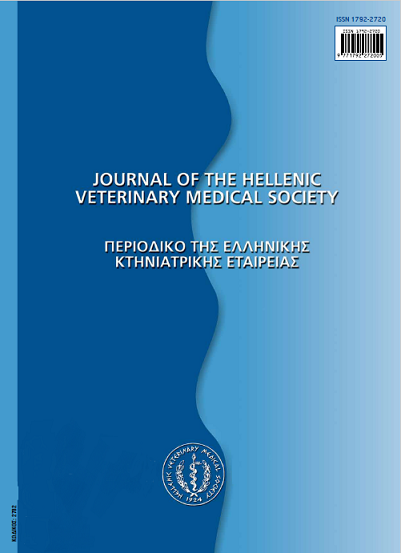Οργανικές εγκεφαλοπάθειες στο σκύλο: αναδρομική μελέτη 48 περιστατικών (2008-2012)

Περίληψη
Η παρούσα αναδρομική μελέτη αφορά σε 48 περιστατικά σκύλων, με κλινική εικόνα οργανικής εγκεφαλοπάθειας, που είχαν προσκομιστεί στην Κλινική Ζώων Συντροφιάς της Κτηνιατρικής Σχολής Α.Π.Θ. στο διάστημα της τελευταίας πενταετίας (2008-2012). Οι περισσότεροι σκύλοι ήταν ενήλικοι, μάλιστα υπερήλικοι (ηλικίας άνω των 10 ετών), και ανήκαν σε καθαρόαιμες φυλές ή μιγάδες τους. Η εκδήλωση των νευρολογικών διαταραχών ήταν απότομη σε 11, υποξεία σε 12 και προοδευτική σε 24 ζώα. Η νευροανατομική εντόπιση των αλλοιώσεων ήταν εστιακή σε 31 σκύλους και στην πλειονότητά αφορούσε στα ημισφαίρια και στο στέλεχος του εγκεφάλου, ενώ μόνο σε 4 περιστατικά διαπιστώθηκε παρεγκεφαλιδικό σύνδρομο. Οι υπόλοιποι 17 σκύλοι εκδήλωσαν συμπτωματολογία διάχυτης εγκεφαλοπάθειας. Η αιτιολογική διάγνωση ήταν εφικτή σε 29 περιστατικά και περιλάμβανε τα νεοπλάσματα (πρωτογενή και μεταστατικά) του εγκεφάλου (10/29), την εγκεφαλίτιδα διάφορης αιτιολογίας (9/29), τα συγγενή και κληρονομικά νοσήματα (6/29) και τη ισχαιμική εγκεφαλοπάθεια (1/29). Στις λοιπές περιπτώσεις δεν προσδιορίστηκε το αίτιο της εγκεφαλοπάθειας, αν και σε 8 σκύλους υπήρξαν ενδείξεις της αιτιολογίας της. Οι περισσότεροι σκύλοι πέθαναν (13/48) από επιπλοκές της εγκεφαλοπάθειας ή τούς έγινε ευθανασία (24/48) λόγω της βαρύτητας της κλινικής τους εικόνας. Έξι από αυτούς ζουν μέχρι σήμερα με συμπτωματική και υποστηρικτική θεραπεία, ενώ για πέντε ζώα δεν είναι γνωστό κανένα νεότερο δεδομένο.
Λεπτομέρειες άρθρου
- Πώς να δημιουργήσετε Αναφορές
-
POLIZOPOULOU (Ζ.Σ. ΠΟΛΥΖΟΠΟΥΛΟΥ) Z. S., ELEKIDOU (Ε. ΕΛΕΚΙΔΟΥ) E., PATSIKAS (Μ.Ν. ΠΑΤΣΙΚΑΣ) M. N., BRELLOU (Γ. ΜΠΡΕΛΛΟΥ) G., & SOUBASIS (Ν. ΣΟΥΜΠΑΣΗΣ) N. (2017). Οργανικές εγκεφαλοπάθειες στο σκύλο: αναδρομική μελέτη 48 περιστατικών (2008-2012). Περιοδικό της Ελληνικής Κτηνιατρικής Εταιρείας, 64(3), 183–192. https://doi.org/10.12681/jhvms.15498
- Τεύχος
- Τόμ. 64 Αρ. 3 (2013)
- Ενότητα
- Research Articles
Οι συγγραφείς των άρθρων που δημοσιεύονται στο περιοδικό διατηρούν τα δικαιώματα πνευματικής ιδιοκτησίας επί των άρθρων τους, δίνοντας στο περιοδικό το δικαίωμα της πρώτης δημοσίευσης.
Άρθρα που δημοσιεύονται στο περιοδικό διατίθενται με άδεια Creative Commons 4.0 Non Commercial και σύμφωνα με την άδεια μπορούν να χρησιμοποιούνται ελεύθερα, με αναφορά στο/στη συγγραφέα και στην πρώτη δημοσίευση για μη κερδοσκοπικούς σκοπούς.
Οι συγγραφείς μπορούν να καταθέσουν το άρθρο σε ιδρυματικό ή άλλο αποθετήριο ή/και να το δημοσιεύσουν σε άλλη έκδοση, με υποχρεωτική την αναφορά πρώτης δημοσίευσης στο J Hellenic Vet Med Soc
Οι συγγραφείς ενθαρρύνονται να καταθέσουν σε αποθετήριο ή να δημοσιεύσουν την εργασία τους στο διαδίκτυο πριν ή κατά τη διαδικασία υποβολής και αξιολόγησής της.









